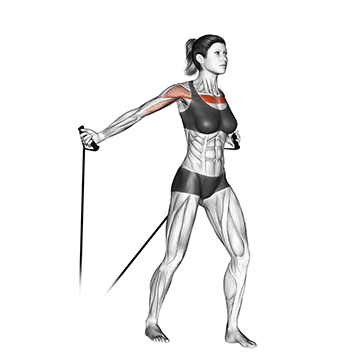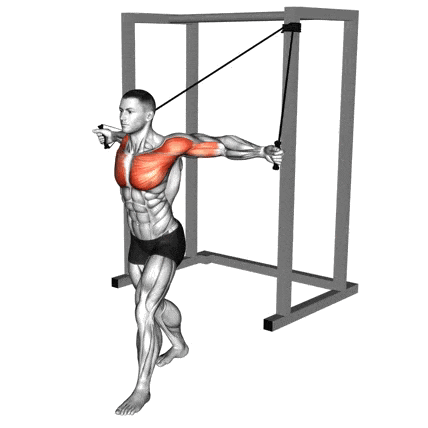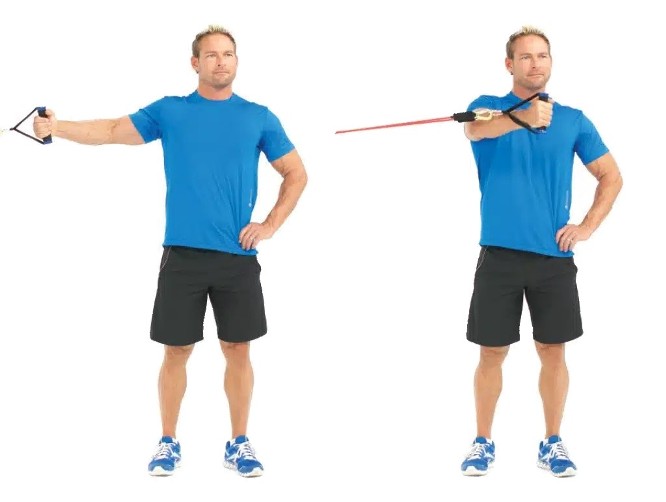If you want to build an impressive chest without expensive gym equipment, resistance band chest flys are your secret weapon.
Why?
Three key reasons:
Superior Tension Control. Unlike dumbbells, resistance bands maintain constant tension on your chest throughout the entire movement. This means every second of your rep counts toward muscle growth.
Better Resistance Curve Think about traditional dumbbell flys. The resistance drops off at the top of the movement. With bands? You get consistent, smooth resistance from start to finish.
Peak Adaptability. Whether you’re just starting out or you’re an advanced lifter, you can instantly modify the difficulty by:
- Adjusting your stance width
- Using different band resistances
- Changing anchor positions
There are different variations of resistance band chest fly that you can try, such as
- Low to high chest fly,
- Standing chest fly, and
- Single arm banded chest fly.
Want to take your gains to the next level? Discover your daily calorie needs with our free TDEE calculator

Resistance Band Fly Muscles Worked
- Primary: Pectoralis Major (Chest)
- Secondary: Anterior deltoids (front shoulders) Biceps (short head)
- Stabilizing: Serratus Anterior, Core Muscles, Rotator Cuff
How To Do Standing Resistance Band Chest Fly
- Secure one end of your resistance band to a sturdy anchor point, like a doorknob, bed frame, or a wall-mounted hook.
- Stand facing away from the anchor point, feet shoulder-width apart. Hold one end of the band in each hand.
- Step forward until you feel light tension in the band and position your arms out to the sides at shoulder height, elbows slightly bent.
- Bring your hands together in front of your chest, squeezing those chest muscles as they come close. Feel the burn!
- Gradually bring your hands back to the starting position to complete one rep
Tips and Forms
- First thing: Lock your shoulder blades together before you move. Imagine squeezing a pencil between them.
- Want more chest engagement? Slightly rotate your palms inward as you bring them together.
- If you can do more than 15 clean reps, your band is too light. Move to the high-resistance band.
- Focus on squeezing your chest at the end of the movement, like you’re trying to press your inner pecs together. Hold this peak contraction briefly to enhance chest activation.
- Bands should remain taut throughout the movement. Do not let your hands drop below chest level.
- Keep your shoulders down and be careful not to shrug or hunch them up.
- If you are new to this exercise, start with lower reps, like 8-10. Intermediate do 3–4 sets of 12–15 reps.
Variations Of Band Chest Fly
We can also perform this exercise in some variations, such as “Low to high band fly,” “High to low band fly,” or “single-hand fly.”
Now let’s talk about these variations and how to perform them properly.
1. Resistance Band Low To High Band Fly
The low-to-high chest fly, also known as the low band fly, is the best chest exercise for training the chest at various angles and strengthening the chest and shoulders.
It primarily targets the upper chest by pulling the arms from a low to high angle.

2. Resistance Band High To Low Band Fly
High cable chest fly, also known as high to low cable fly, is the best chest exercise.
While traditional flyes hit your chest pretty evenly, the high-to-low variation preferentially targets those stubborn lower pec fibers.
If you’re new to this, start with a lighter band than you’d use for regular flyes. Your chest and shoulders will thank me later.

3. Resistance Band Single Arm Fly
Let’s be honest – most of us have one side stronger than the other. The single-arm fly forces each pec to pull its own weight (literally). No more letting your dominant side do all the heavy lifting.
It helps to fix muscle imbalances.
When you perform a single-arm fly, your body has to fight rotational forces that don’t exist in the standard version. Your core literally has to work overtime to keep you stable.


Manish is a NASM-certified fitness and nutrition coach with over 10 years of experience in weight lifting and fat loss fitness coaching. He specializes in gym-based training and has a lot of knowledge about exercise, lifting technique, biomechanics, and more.
Through “Fit Life Regime,” he generously shares the insights he’s gained over a decade in the field. His goal is to equip others with the knowledge to start their own fitness journey.
